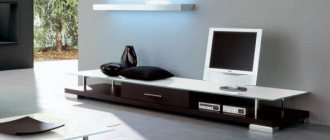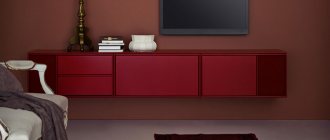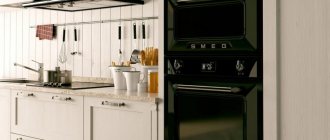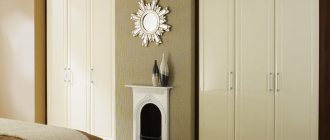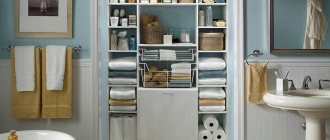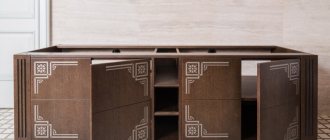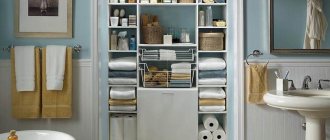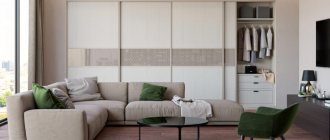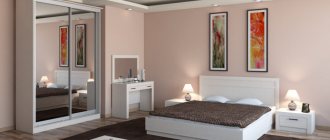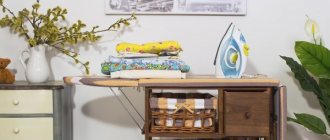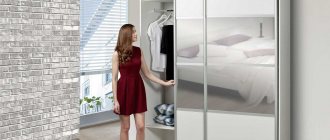<
>
The small dimensions of the living room often lead to the need to install the TV on a cabinet. Although, if you choose the right model, then in a large room this approach will allow you to get rid of the clutter of furniture. One of the most original solutions will be a glass TV stand.
Glass TV stand in the interior - advantages and features
When choosing glass models, a considerable list of their advantages immediately emerges:
- Will create the effect of lightness. Even serious structures with large dimensions visually lose weight, thanks to the ability of glass to diffuse light;
- Compatibility with other materials. Glass goes well with the vast majority of modern materials. It will look equally beautiful in combination with wood, plastic or chromed steel;
- Will fit into any interior. It is unlikely that you will find a style in which glass will look out of place;
- Rich possibilities in terms of design and decor. There is no limit to the imagination of designers;
- Relatively low price tag. You don’t have to go broke paying exorbitant sums;
- Complete environmental safety. Glass does not emit any toxic substances. Does not react with the environment. Completely neutral material;
- Heat resistance. The material does not burn or melt. Although contact with open fire will still spoil the appearance of the product.
Unfortunately, there are also disadvantages. It is better to avoid such cabinets if there are small children in the house. Even without taking into account the fact that they will significantly spoil the appearance with handprints, children can easily be injured by fragments. It is difficult to explain to them that hitting glass with heavy objects is not a good idea. In any case, you will be tortured to erase all the “traces” of their pranks from the cabinet. In addition, many types of glass are susceptible to mechanical damage. You can no longer disguise the scratches that appear.
Color spectrum
The color scheme for the cabinet is selected in accordance with the prevailing color scheme of the room. Transparent options consisting of metal stands and clear glass will look great together with light-colored appliances - white or silver. Such a cabinet will look airy and not unobtrusive.
If the interior has a predominance of dark tones, then black design, tinted glass to “volcanic”, smoky or brown shades are suitable. The black body and the TV screen will harmoniously combine, creating a single ensemble. When choosing models with wooden cabinet parts, when deciding whether to give preference to mahogany or choose Sonoma oak, proceed from the other pieces of furniture in the room.
For lovers of original design solutions, a palette of cabinets that contrasts with the interior can be chosen with decorative effects such as applying a pattern to glass or varnishing using the marbling technique. Sometimes, multi-colored glass panels are created for individual interiors.
It is important that the design of the cabinet does not conflict with the screen. Too bright a color can be distracting and irritating to the viewer.
What kind of glass is used in the manufacture of glass TV stands?
Most often, the following varieties of this material are used to make glass TV stands:
- Tempered. Standard thickness can vary from 8 to 20 mm. The formation is first heated at a temperature of 600°C and then very sharply cooled. After tempering glass, its strength increases significantly. Such a sheet can support the weight of an adult. But, when hit from the end, the layer crumbles into many blunt pieces. It’s impossible to get hurt by them, but there will be a lot of debris. But it cannot be scratched. Cannot be drilled;
- Textural. People call it “crushed ice.” Fine glass chips are placed inside the tempered sheet;
- Float. The most common option. Smooth, even, actively used in the manufacture of furniture. It has an affordable price tag;
- Triplex. Several glass layers are combined into one using shockproof films or a special liquid. This type of glass is often called laminated glass. Very durable, but quite weighty. If you manage to break it, it will be large pieces covered with a network of cracks;
- Stemalit (enameled). On one side, the glass sheet is painted with special enamel. After which it is melted. The paint becomes part of the sheet and cannot be removed. It cannot be cut or drilled by hand, as it is a type of tempered glass;
- Lakobel. Painted float glass. It is not subject to hardening;
- Fiberglass. Very light, unbreakable material. Does not scratch. High level of strength;
- Acrylic (plexiglass). A very plastic material, amenable to all types of processing (cutting, drilling, gluing). It is painted in mass in all possible colors. Almost 3 times lighter than ordinary glass and 5 times stronger. It is very difficult to break it. Its only drawback is its instability to scratches;
- Optiwhite. Clarified glass with maximum light transmittance;
- With optical effect. From different viewing angles it may appear transparent, tinted or mirrored. Multilayer. Between the layers there is a thin layer with a liquid crystal base.
Particular attention should be paid to the absence of defective defects. These are considered:
- "Midge". If you run your hand over the glass, you will feel multiple sharp crystalline inclusions. They can be in the thickness of the glass;
- Single or overlapping closed bubbles. For furniture, this is a reason for discarding;
- Open blisters;
- Funnel-shaped or straight chips with stratification. Always check the edge. This defect is the result of poor quality cutting;
- Sharp teeth;
- Multiple scratches deeper than 0.02 mm and visible from the outside.
Varieties
Design solutions in the production of glass TV stands are amazing. While models made in China are more laconic and functional, European designers offer cabinets in very original formats. For the production of interior items, special tempered glass is used. The process is similar to that used for metal: silicate glass is heated to the desired temperature and cooled sharply. The crystal lattice receives tension, ensuring the strength of the material during further use. What is also important is that tempered glass can be called safe. If the surface becomes chipped or broken upon impact, the edges will have blunt edges, meaning there will be minimal chance of injury.
The models of cabinets offered on the market have a lot of differences. Considering that you will not find an entirely glass cabinet, since in addition to glass you need strong supports that can withstand the weight of the installed equipment, all possible combinations of materials are implied. The TV stand will have a glass facade or horizontal surfaces, and the rest of the body can be forged or made of MDF in Sonoma oak color.
Based on materials
We propose to consider specific types of materials most often used in combination with glass. Chromed and matte steel parts are often used in modern, urban interiors. Against the backdrop of technology, a TV stand will become a weightless and effective addition, decorated with colorful shiny stands. You can find painted metal, which looks no less stylish.
Chipboard is too unreliable in this case. High-quality wood species in combination with glass find a place in modern interior solutions that claim to be classics. Most often, in this solution, a dark wooden body will be combined with a light glass tabletop. Glass can also decorate the facade. An alternative solution for light interiors is Sonoma oak in combination with dark graphite-colored glass. The façade is often closed.
The combination of plastic can most often be found in modern, high-tech, eclectic options with elements of pop art. Often such models have an original, bold design and bright body colors. The glass in this case can also be colored black or lapis lazuli. Such items are selected very carefully, focusing on the palette of the room as a whole or a contrasting solution.
What do you think of the glass and stone TV stand? Often this combination is offered as an exclusive design proposal for a specific interior. The stone can be either natural or artificial. Photos of such substantial pieces of furniture can show off in bright catalogs and portfolios of famous interior design masters. Due to the high cost of materials, such a TV stand can literally turn out to be “precious”.
Whatever material is chosen as a companion to glass, the product as a whole should fit harmoniously into the overall interior.
By type of glass
Glass surfaces can be tinted and subjected to various types of processing in order to obtain decorative effects. TV stands can present a laconic transparent surface or turn into a real work of art:
- The simplest option is clear tempered glass. For television equipment, a light-colored housing is most suitable;
- matte - the surface is treated with sandblasting equipment. You can choose a uniform type of processing or decor by applying a pattern. Looks very stylish even in modern interiors;
- tinting - previously we could choose black or dark brown tinting. A classic option is the combination of dark glass and “Sonoma oak” shade in MDF. The black color of the glass was combined with the classic design of the body of most televisions. Ideas about pieces of furniture have changed and now glass is painted in the brightest shades;
- lacquered glass - this method of decorating glass can offer interesting design solutions;
- textured glass - “crushed ice effect”. At first glance, you might think that the surface is broken glass. In principle, this is true, but with a caveat: the fragments are placed between layers of tempered glass. The result is an original exterior surface and sufficient strength of the material.
The decorative design of glass surfaces also implies the functionality of the product as a whole.
Texture
Matte
Normal
Tinted
By shape
In terms of shape, manufacturers of glass TV stands try to take into account all the wishes of customers. You can find classic and most original solutions. A cabinet means a system of horizontal shelf surfaces with a durable tabletop or top shelf on which the TV is installed.
- straight type cabinet - usually placed along one of the walls. It can be presented as a console version, mounted on the wall. This form is familiar and in demand among consumers;
- curved tabletop - such samples are most often distinguished by their original facade in addition to the tabletop. The outlines can be either regular - radius or oval, or irregular in shape. The complexity of the configuration and decor make such a cabinet an original addition to the interior of the living room or bedroom;
- corner configuration - such a cabinet has a trapezoid or triangle in cross-section. The facade is made rounded or panoramic;
- plasma stand - here the shape can be very original. The metal frame with glass is complemented by a mounting frame for installing the TV. The design is complex and may include glass shelves, as well as parts of the body;
- rotating stands are a separate original example of a cabinet for video equipment. In addition to space for the TV, the racks provide space to place almost all the media equipment in the apartment.
You should choose a TV stand based on the features of the room. Stylistics of the interior and available items of TV equipment.
Rotating
Curvilinear
Plasma stand
Straight
Corner
Types of glass decor
When choosing a glass TV stand, pay attention to the types of decor. This plastic material is fertile ground:
- Dairy. The glass is etched using acid. Loses transparency completely or partially. External gloss is maintained. Opal glass is immediately produced with a milky tint without the use of chemicals;
- Matted. For this purpose, sandblasting technique is used. Quartz crystals under pressure leave small scratches on the glass. At this point the surface becomes matte, white, and opaque. In this way, you can apply a drawing using templates;
- Tinted. Color pigments are applied from the inside or throughout the glass. Beautiful colors like bronze, graphite, gold will give your living room or bedroom a special chic;
- Engraving. The drawing is applied using a laser machine. The contour turns out to be deep and voluminous. In this case, no harm is caused to the glass itself. Any degree of pattern complexity is allowed. Does not wear off over time;
- Stained glass painting. Chic appearance. Allows the application of a volumetric contour between fragments of the pattern. If the design is coated with acrylic varnish, the surface can be washed. For this, acrylic or special stained glass paints are used.
Facades
The glass TV stand can be of an open type or equipped with a facade.
In the first case, the model is a bookcase. The shelves are fixed on metal racks or side walls. The back panel is missing. The product does not clutter up the space, provides quick access to the contents, but requires regular care and maintenance of order. You should not load the shelves chaotically, this causes a feeling of clutter and kills the effect of airiness and weightlessness.
Closed facades protect the contents of furniture from contamination and ultraviolet rays. But it is advisable to leave some of the compartments open. The absence of partitions will ensure natural cooling of the equipment.
Designs of glass television stands
In an all-glass cabinet, the usual frame of the case is completely absent. Most often, this is a design of several open shelves with corner posts made of metal or wood. The back wall in this version is also removable. Its place is taken by a narrow vertical bar. These designs are characterized by elegance and airiness. Look great in any setting. A standard frame appears if only the door leaves are made of glass. The shelves in this case are made of basic material. The models have regular geometric shapes. They look a little heavy. You can also come across an option when glass is mounted on top of the base material. For example, thin glass sheets are attached on top of an MDF cabinet. Very original appearance.
Advantages and disadvantages
For the manufacture of such furniture, not ordinary glass is used, but tempered glass, which ensures its increased mechanical strength. Even if such a cabinet breaks, many small fragments with blunt edges will form, which will not cause serious injury to a person. This effect is clear evidence of the high impact strength of the material.
Advantages of glass structures:
- They have mechanical strength and heat resistance.
- Safe from damage.
- They are used to decorate interiors in different styles.
- They look aesthetically pleasing and delight with their impeccable shine.
There are also disadvantages - such products require regular and careful care, as they quickly become covered with dust. Also, marks from hands and dishes often remain on the surface. However, their main disadvantage is the inability to eliminate scratches and chips.
When developing the concept of a future interior, it is necessary that all details are in harmony with each other . If you choose the wrong glass furniture, the atmosphere in the room will be cold and uncomfortable. But when the product is combined with the geometry of the room, a glass cabinet or shelf for a TV will visually increase the area and emphasize the design features.
Typical sizes
When deciding how to choose the appropriate size of the cabinet, focus on the size of the TV. Ideally, it should be 35% wider than the screen. The following types of forms are distinguished:
- High. It is a structure consisting of 4 – 5 through shelves with side supports. Such models are called racks. The height can vary from 75 to 90 cm. The same values are maintained for the width. The depth does not exceed 50 cm;
- Narrow. The depth parameter cannot be less than 35 cm. The width varies, but the average is 60 cm;
- Wide. They start in width from 1 to 1.4 meters. The wider the cabinet, the more complex its design will be. The depth in this case is at least 40 cm.
Facade options
A special feature of modern glass TV stands is the absence of a front door system. In this case, the housing frame is most often removed. They are very similar to whatnots. At the same time, models are still produced where glass is used to make only cabinet doors. They are made sliding. Slides to the side without taking up space in front of the cabinet.
Shapes and sizes
Glass TV tables can be of any shape and size. Popular options:
- The straight cabinet is a simple, reliable design and does not have any additional functions.
- Corner is the best option for small areas. It is installed directly in the corner, thereby freeing up a lot of space in the room. The furniture is perfect for placing TVs of any format, from small to huge.
- Hanging - attached to the wall, thanks to its shape it visually makes the room more spacious.
- The stand is convenient and compact. There are many modifications of such products.
- Plasma stand-stand - this model has a built-in mount for TV and a cable channel for wires. Thanks to this mechanism, there is no need to make holes in the wall.
- With glass doors it looks impressive, and thanks to the closed design, it can be used for storing books and dishes. If the facade and side walls of the furniture are matte, then you can even place clothes and shoes in it.
Subtleties of choosing and placing cabinets in the hallway of different sizes
The range of modern cabinets is very wide, which allows you to choose the ideal option. When choosing, you should measure the length of the TV, as well as the area of the room where the furniture will be placed. The edges of the appliance are not allowed to protrude beyond the edges of the tabletop, as there is a risk of snagging and damaging the appliance.
Recommendations to help you choose the size of the bedside table:
- A model with a height of 40–45 cm and a length of 90–120 cm is suitable for those who have a low sofa in their apartment.
- The average height (55–70 cm) of the product is universal; it makes it possible to view programs from anywhere in the room.
- Glass cabinets with a height of 70–90 cm and a length of 100–140 cm are also considered a standard size (convenient for watching movies with a large family).
- With a product height of 90–120 cm and a length of 50–60 cm, it is difficult to install a modern plasma, and watching TV shows is extremely uncomfortable, since you need to raise your head high.
The eyes should be level with the middle of the screen. Calculating the position of the display in each individual room must be approached individually. The larger the diagonal, the farther people should sit from the TV.
Straight
Corner Hanging
Rack
Plasma stand With glass doors
Additional equipment
A special role is played by additional equipment of the selected model:
- Shelf for related equipment. In principle, the through design with the absence of a back wall allows any desired shelf to be used for this purpose. But, often the design includes special shelves with reduced dimensions. Don't put speakers on them. When turned on, they create vibrations. The glossy surface of the glass responds to this by sliding the speakers along the shelves. And it is also very harmful for the TV. Take care of expensive equipment. Repairing or replacing it will also cost you a pretty penny;
- TV holder. This element is added again due to the smoothness of the base material. The special stand can be adjusted in height, and the petals of the bracket allow you to change the angle of inclination and the height of the screen placement;
- Rotating platform. It is an oval panel, only slightly smaller in size than the top shelf of the cabinet. It is attached using a special movable semicircular element. Due to this, it can be tilted in different directions and rotated. This way you can adjust the angles of tilt or rotation of the screen on TVs with a fixed support.
Equipment
TV stands are complemented by various functionality.
- The rotating platform allows you to choose the optimal viewing angle.
- A stand with a holder in the form of a bracket makes it possible to change the height, tilt and rotation of the television receiver.
- The cable channel will disguise numerous wires.
- The lighting matches perfectly with glass products and creates interesting effects.
Rules for caring for a glass TV stand
Despite its transparency, glass in everyday life does not have many maintenance requirements:
- The use of all types of abrasives is prohibited. This applies not only to the products, but also to the napkins with which you wipe the shelves. Only soft microfiber and washing gels or emulsions. This is due to the tendency of glass to form scratches;
- After cleaning, be sure to wipe the surface until the moisture is completely absorbed. Otherwise, the glass will become covered with stains, smudges and will look significantly worse than before washing;
- Don't put off cleaning for too long. If you notice the appearance of greasy spots or “fingers”, wipe them off immediately. Then it will be much more difficult for you;
- The material does not like sudden temperature changes. Do not place a mug of hot coffee on the surface of the cabinet without using a napkin or stand;
<
>
- It is prohibited to use a cabinet with defects in the form of chips and cracks. This is dangerous not only for the equipment placed on it. This carries a risk of injury to the individual;
- Avoid overloading. Despite the fact that modern glass cabinets can withstand a load of at least 100 kg, the weight is calculated for the entire structure. Each individual shelf will be significantly weaker. This indicator is also affected by its width. The longer the working surface, the less load the shelf can withstand without internal microdamage. The optimal weight is 7 kg per individual glass plane;
- Avoid contact of glass with sharp metal objects;
- Glass does not like vibrations. Therefore, do not place speakers, low-frequency subwoofers and similar equipment on shelves. This way you will not only extend the life of the cabinet, but also protect your TV. It tolerates constant vibrations even worse than glass.
Rules of care
Glass surfaces tend to accumulate dust and fingerprints and therefore require constant care.
For daily cleaning, it is recommended to use a dry soft microfiber cloth, special products containing alcohol or ammonia. Grease stains are removed with a mild soap solution.
It is unacceptable to use household chemicals that contain abrasives and caustic alkalis.
A soft broom will help remove dust from shelves filled with various objects.
Cloudy glass can be restored to its former shine using vinegar and water (component ratio 1:3). Finally, the surfaces are wiped with linen cloth.
To avoid damage, it is not recommended:
- place hot objects on the glass;
- exceed the permissible load;
- allow contact with sharp metal objects, shock and vibration.
Recommendations for placing a TV stand in the interior of a room
The main rule is proper centering of the cabinet. A modern flat-screen TV can easily be classified as a key element of the living room. All glass models are organically combined with them. But, the placement of the cabinet must first of all guarantee a high-quality full view of the screen. Without piling up around massive furniture.
A low coffee table placed opposite the cabinet looks beautiful. It will be even better if they are made in the same style. In general, glass furniture does not really like being alone. Add decorative elements to her shelves in the form of vases, glass trinkets or dishes. The overall appearance of the cabinet in the interior will sparkle with new colors.
Place additional light sources on the sides. In order not to spoil your TV viewing, choose medium-sized wall sconces. Place them below the center of the TV screen. From this position, they will not spoil your color, but will help the glass to reveal itself in all its glory.
Side symmetrical narrow pencil cases will look very nice. This is especially true for models with a partially glazed facade (type of shop windows). Choose the right color scheme and you will have an excellent stylistic ensemble.
Location options
The cabinets on which the TV and other video equipment are installed occupy a central position in the living room - after all, all residents of the apartment are involved in watching TV channels. If it comes to the bedroom, then the location depends on the position of the bed.
The interior item is located along one of the walls or in a corner position. It should be taken into account that the equipment requires certain operating conditions - no direct sunlight and good ventilation. When looking at the screen, it should not be illuminated by bright sunlight.
If the model of the cabinet is a cantilever type, that is, it is attached directly to the wall, then the wall must be load-bearing, since a thin plasterboard may not withstand the total weight of the fixed and installed furniture and equipment.
You should not install the TV stand next to a heating source. We remember that the materials for manufacturing are combined with glass. If in your case the companion is wood, MDF or plastic, installation next to the radiator can shorten the service life of the cabinet and the equipment installed on it.
Photo of glass TV stands in the interior
<
>
Glass pieces of furniture not only fit well into any style, but they themselves can add additional accents, becoming a key element of the decor. At the same time, they will provide you with a complete storage system.
